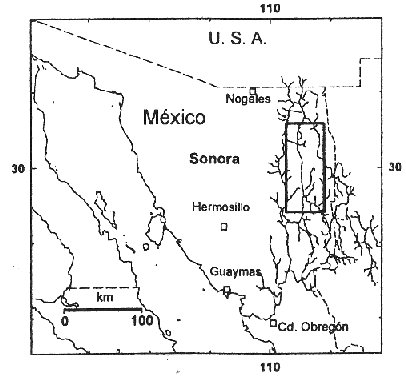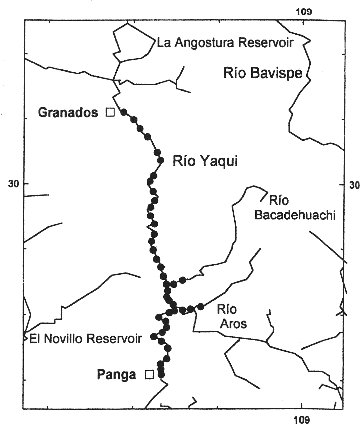 |
Last Update:
Thursday November 22, 2018
|
| [Home] |
INTRODUCTION There are few published records of river otters from the northeastern watershed of the Sierra Madre Occidental of Mexico. Of these only four records are from the State of Sonora. One record is from Río Mulatos a Río Yaqui affluent ( Roth and Cockrum, 1976 ). Another one is from from Bajo (lower) Río Yaqui, where Brown et al. (1982) observed river otters, downriver of the confluence of Río Chico. They suggest that this species could be found in Arizona, due that Río Yaqui affluents extend to the north. The other two records are from Río Mayo ( Cockrum, 1964 , Roth and Cockrum, 1976 ) ( Fig. 1 ). These scattered observations indicate a low effort of observation for river otters, although other researchers (i.e. fish and birds) have done an extensive effort in several parts of the river and have reported few signs of river otters.
It is important to know the actual distribution and the status of river otter populations in the watershed of the Sierra Madre Occidental. Of particular relevance is the Río Yaqui-Bavispe watershed, which starts in the American southwest (southeast Arizona) and reach the Gulf of California, close to Ciudad Obregón (see Fig. 1 ). The knowledge of this species distribution will give insight on its status and to confirm the hypothesis of Gallo (1989) in which he stated that “the flow of the water to the south acts as a geographic barrier for the northern distribution of this neotropical species of river otters”. An expedition to survey the status of the Neotropical river otters and bald eagles (Haliaeetus leucocephalus) in the Río Yaqui, was conducted from 1-7 May 1995 STUDY AREA The Río Yaqui-Bavispe basin which carries the 70% of the river water in the State of Sonora is the most important in Northwestern Mexico. It is situated between 27° and 31° N, and from 108° to 111° W, and occupies around the 30% of the State area ( Fig. 1 ). A large portion originates in the western watershed of the Sierra Madre Occidental in the southwestern portion of the State of Chihuahua. The northern portion originates in the southeastern corner of Arizona. The basin has an extension of approximately 73,000 km² with a total length of 740 km. Three large dams control its flow: La Angostura Reservoir in the northern portion over the Río Bavispe, El Novillo Reservoir in the mid-Yaqui, and Oviachic Reservoir to the south, near to Ciudad Obregón ( Hendrickson et al., 1981 , Bojórquez et al., 1985 ). METHODS Survey methodology consisted in canoeing a large portion of the river (135 km), this helped to perform a detailed and quieter search for river otter presence. Specific areas like affluents and small creeks and, large, secluded and shadowed pools were searched by walking on the river banks, looking for tracks, dens, foraging sites and other indirect evidence of the river otter presence. This has been successfully in other rivers where this species was preferentially found in secluded areas ( Gallo, 1989 ). Tracks were followed to find the dens, foraging sites, scent marking sites and latrines. In the best case direct observations of individuals of the species were obtained. Interviews with ranchers and fishermen were conducted to know certain aspects of the distribution of the species along the river. This helped evaluate the actual use of the species, if they were hunted locally or if they are used as an extra income by selling their fur. Visits to the local tanneries were done to obtain a major number of records and possible some specimens (skulls, skeletons and furs) of this species. To characterize the diet and the preferential prey of river otters, the scats and rests of specimens in foraging sites were collected and analyzed following Greer (1955) , Sheldon and Toll (1964) and Gallo (1989) . The habitats occupied by river otters were described: riparian vegetation, geologic features and hydrologic characteristics (perennial and temporal/ or intermittent flow). Water temperature averaged 22°C. The river gradient averages 1.3 m/ km, from Granados to Panga (see Fig. 1 ), a drop of about 200 m. RESULTS AND DISCUSSION The population of river otters in the Río Yaqui is abundant in several isolated non-perturbed areas, were there is no fishing or water extraction for farming, and cattle growing is the main human activity. They were more scarce in perturbed areas by farming, urban and industrial uses (mining). Illegal hunting still exists, but due to this species crepuscular-nocturnal activities, they are difficult to hunt. In general terms their status is of little perturbation with abundant populations in areas of difficult access were few human activities takes place. As many as 42 new sites with evidence of Neotropical river otters were found in a stretch of 135 km of river, two of them were direct observations of otters (a young otter resting in a large sandbar and a larger otter that jumped from a ledge to a deep pool when we approached with the canoe). The rest were of indirect evidence and consisted of latrines, footprints, rests of foraging and dens ( Fig. 2 ).
A gross analysis of the diet indicates that they prey mainly on fish; four species (90 %) were dominant: the Channel catfish, Ictalurus punctatus (introduced), the yellow catfish, Ameiurus melas (introduced), the black bass, Micropterus salmoides (introduced), the flathead catfish, Pylodictis olivaris (introduced), and the Tilapia, Tilapia sp. (introduced), a small portion (5%) of the diet was composed by native fishes, mainly Yaqui catfish, Ictalurus pricei, and Yaqui sardine, Notropis formosus. Small fish scales, feathers, fur and remains of frogs and insects were also found, forming the residual 5%. It is important to note that the majority of the diet is composed by introduced fish, which probably have influenced positively the growth of the river otter population. This diet is mainly piscivorous compared to other areas of Mexico were the diet is composed mainly by crustaceans (84.2%) ( Gallo, 1989 ).
By using the following index, the abundance of otters was calculated: No. of otters/ km = No. of scats in the area/ (average rate of defecation); the index is then divided by the total km surveyed. The average rate of defecation was found to be 3 per day, after observing the number of scats produced by two captive adult female otters in the Manuel Alvarez del Toro Zoo in Tuxtla Gutiérrez, State of Chiapas. Then: No. of otters = 139 scats counted/ (3) = 46.3/ 135 km. Giving an abundance of 0.34 otters/ km. These results show a similar abundance than in other areas of México, where an abundance of 0.45 otters/ km have been reported for the Laguna de Catemaco, State of Veracruz (Ruíz, personal communication). Acknowledgements - This work was possible thanks to the invitation of S. Anderson from the Nature Conservancy, Tucson, Arizona to visit the Río Yaqui. Thanks to P. Warren, R. Mesta from U.S. Fish and Wildlife Services and the participants of the expedition, D. Gori and S. Wilson, Judy and Jim. Thanks to H. Medina from CIDESON who drove the treacherous dirt roads of Sierra Madre Occidental. REFERENCES
Bojórquez, L., Aguirre, R., Ortega, A. (1985). Río Yaqui watershed, Northwestern México: use and management. Riparian Ecosystems Management Conference. USDA General Tech. Rep. RM 120. pp. 475-478 |
| [Copyright © 2006 - 2050 IUCN/SSC OSG] | [Home] | [Contact Us] |

